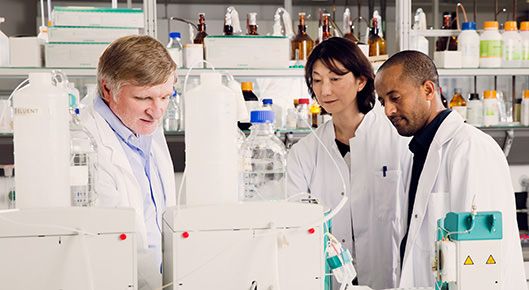MAR-DSW Analyses Decomposition of Toxic Products in Drinking Water Infiltration
Published on by Water Network Research, Official research team of The Water Network in Academic
Desalinated seawater can easily be stored underground. However, toxic by-products occur during infiltration. And these are something Professor Christoph Schüth and his team are taking a closer look at. Their aim: to have the best-quality drinking water for arid areas.
Israel has declared war against drought. Five desalination plants generate around 600 million cubic metres of fresh water every year, which is about 70 percent of the consumption required by private households. Because the vast plants cannot be regulated flexibly, in times of lower demand and when the supply lines are being worked on, the country has too much of the precious wet stuff.

Prof. Schüth, Dr. Sakaguchi-Söder and doctoral candidate Abrha (l. to r.) examining toxic substances in water. Image: Katrin Binner
“They need intermediate storage capacity,” says Prof. Dr. Christoph Schüth, Professor of Hydrogeology at the TU Darmstadt. The water is fed into porous layers in the subsurface known as aquifers, and stays there until it is needed. This has one disadvantage: the desalinated water is chlorinated. If it seeps through the soil, the chlorine reacts with organic substances in the soil and toxic compounds such as chloroform are formed.
In the German-Israeli joint project “MAR-DSW”, Schüth, Dr. Kaori Sakaguchi-Söder and doctoral candidate Behane Abrha want to find out what happens to these trihalomethanes in the water.
They do this using stable isotope analysis, a method which Sakaguchi-Söder has developed further in her doctoral thesis and customised for the analyses in Israel. “This method is a speciality of the TU, and it enables us to establish the isotopic composition of all elements that form the trihalomethanes,” she explains. Water samples are taken from various points of the aquifer and analyzed in a gas chromatograph that “blows up” the molecules in it.
The researchers can then examine the isotopic composition of the fragments. One of the reasons this is significant is that in the breakdown of the harmful substances, the microbes preferentially degrade lighter isotopes. If the sample contains predominantly heavy isotopes, then this means that the breakdown of the harmful by-products is quite advanced. “The analysis of the isotopes can be used to conclude on how fast and to what extend the substance has broken down,” explains Schüth.
In order to correctly interpret the obtained data, the team also simulates the underground microbiological breakdown in the laboratory. Halfway through the research project, “the method is ready to be used,” announces Sakaguchi-Söder. Samples will soon be taken in Israel that will then be analysed in Darmstadt. “The data will be incorporated in a hydrogeological site model,” says Schüth.
The examination method, which was developed at the TU, could be used anywhere in the world where water is stored in aquifers, he adds. The formation of trihalomethanes may differ depending on the soil type, but thanks to MAR-DSW, science and the water industry understand the basic processes that occur during the infiltration of the water.
“In order to respond to the increasing shortage in water with desalination, it is critical that artificial groundwater recharge can be established as a safe and sustainable method,” he continues. “And we are doing our bit to help with this.”
Read full article: TU Darmstadt
Media
Taxonomy
- Treatment
- Chemical Treatment
- Filtration
- Treatment Plants
- Filtration
- Sea Water Filtration
- Filtration
- Sea Water Desalinisation
- Water Management
- water treatment